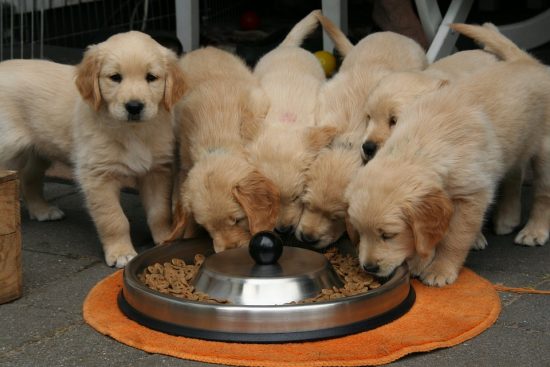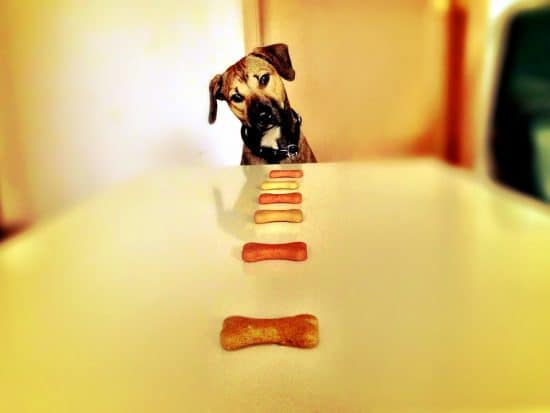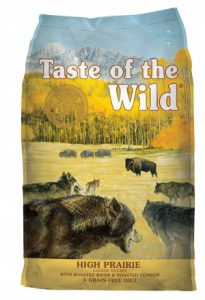If you just got yourself a new puppy, or even if you adopted an older dog, chances are that you want to make sure that you treat him right, and that he will have a long, healthy and happy life with you. Part of that, is knowing the best way to feed your dog, from the type of food he should get, to how much and how many times per day.
Obesity in dogs is just as much of a problem as with humans, but in their case, it’s the owner that needs to make sure that his pet doesn’t get to that stage. Portion control, high quality food and plenty of exercise, these are all important.
Best Way to Feed Dogs
Feeding your dogs food that they enjoy should be something you aim for, while trying to give him all the nutrients he needs. You might have to change his food a couple of times, until you find one that he enjoys.

If your dog doesn’t start eating as soon as you place his bowl down, then you might have to teach him that the food goes away if he doesn’t consume it. Leave the bowl with the food down for 10 minutes, then take it away. He will quickly learn that he should eat all his food, and in the long run you will have a dog that doesn’t give you as many problems.
Top 3 Types of Dog Food That We Recommend
Below, you have three types of dry dog food, that we’re going to recommend to you. They’re good for most dogs, they’re convenient to use (dry dog food), and they use high quality ingredients.
1. Taste of the Wild High Protein Real Meat Recipe Dry Dog Food
Taste of the Wild offers their Canine Formula dry dog food as a premium option, which uses high quality ingredients, has high protein content, along with moderate fat and calories. It’s a great choice for most dogs.
The meat that’s included ranges from lamb, to buffalo, cattle, bison, deer, chicken and even ocean fish. The cereals found in other types of dog food are replaced here with peas and sweet potatoes.
- #1 Ingredient is Real Meat (Roasted Bison & Venison).
- High Protein Ingredients from Trusted Sources.
- Highly Digestable and Nutrient Rich.
- Made in the USA, Family Owned & Run.

2. Wellness Core Natural Grain Free Dry Dog Food Reduced Fat
If your dog is on a diet, then a better alternative might be the Wellness CORE dry dog food, which is a solution I’d recommend for the pets which are obese. It’s got only 10% fat, it has fewer calories, but it will still offer them all the nutrients they need. It’s also without grain, which is a good idea these days, and as far as meat goes, it uses chicken meal.
- 100% Grain Free.
- Reduced Fat Formula.
- All Natural, With Premium Ingredients.
- Made in USA.

3. Blue Buffalo Wilderness Rocky Mountain Recipe High Protein Grain Free
If neither of the two previous options are OK for you or your dog, then we have a third very good option that might do the trick. A type of dry dog food which comes from Blue Wilderness, their Rocky Mountain Recipe is one that a lot of dogs appreciate. It’s grain free, has a high content of protein, and it is considered a premium food.
It has a high amount of calories, high protein and it includes gut-friendly bacteria. The meat comes mostly from beef (it’s chicken free now), while the rest includes peas and tapioca starch.
- Packed With Real Beef
- High Protein & Grain Free.
- Include Blue’s LifeSource Bits (minerals, vitamins and antioxidants).
- Natural Dog Food.

Types of Dog Food – Dry vs Wet

You will do well with either type of dog food, it’s mostly a matter of preference. Provided that it’s a higher quality option, I’d generally recommend dry dog food, just because of its effect on dental hygiene and because it’s easier to store and less messy. Otherwise, a healthier option will often be the wet dog food, because it’s less processed, but it has certain disadvantages for owners, such as price and the fact that it spoils faster and needs refrigeration. As you will learn below, there are pros and cons to both types, and either of these can work generally.
Wet Dog Food – Pros and Cons
A dog, especially if we’re talking about a young one, will often be a bit of a picky eater. For this reason, wet dog food will often be a better choice for them, with smell, consistency and less processing making it a preferable option for them, at least in their eyes. This type of food has more water as well, so it hydrates, something that’s not the case with dry food.
If your dog has some kind of food sensitivity, then this type of food will probably be better for them. Vegetarian versions exist as well, and they’re great for dogs which are sensitive.
As for the cons of wet dog food, one would be the fact that it doesn’t last as long, so you will have to refrigerate it. The dog also has a chance to make a bit of a mess with it, if he’s that kind of eater.
Dry Dog Food – Pros and Cons
Buying dry dog food seems to be the more popular option for most people, as it’s both more convenient and cheaper. You can leave it out and it will not easily spoil, you can take it with you when you travel, it can even be left in a bowl for the dog to eat later, it will be just as good.

Another pro for it, is that it has a texture that is harder and it allows the dog to chew on it, which insures a healthier dental hygiene. Kibble has plenty of protein and carbs, at least if it’s well chosen, and there is a lot more energy obtained from a smaller quantity.
If you go with the cheaper variants of kibble, then you end up with stuff that’s full of artificial flavors, preservatives and generally just lower quality ingredients. The recommendation would be to pick something natural, of high quality, and one example would be the AvoDerm Natural Dry Dog Food.
How Many Times Per Day Should The Dog Eat?
The answer to the question on how many times per day should a dog eat, will depend on the age of the dog.
While it’s still a fast-growing puppy, under 5 months old, the typical recommendation is to give him all the food he needs to get bigger. This means feeding him 3 or 4 meals each day, at regular intervals. He will have plenty of energy to both run around and grow at a normal pace.
As the dog grows and enters adulthood, you should start giving him two meals per day. One meal should be given in the morning, while the second one is reserved for the evening.

How Much Food Should He Eat?
The quantity of food depends on the size of the dog, on how much activity he has each day, but also on the type of food that he’s getting.
For commercially available food, either dry or in a can, follow the instructions on the label. You will typically get indications for dogs, depending on their size. For larger dogs, it will often indicate about three cups per day, for dry food.
When it comes to food that you prepare at home, it’s typically about 2-3% of the dog’s weight. For example, if you have a 50-pound dog, you will need to provide him with about 1-1.5 pounds of cooked food per day, split between his two meals. This should be a combination of vegetables, carbs (rice) and meat.
Eating Position
It’s a good idea not to make it too hard for your dog to eat, so if you can, place the bowl at a bit of height. This way, he will not have to bend his neck so that he can eat the food from the level of the floor. It’s just a good idea to do that, but either way, it’s not essential, the food will disappear into his mouth just as quickly.



